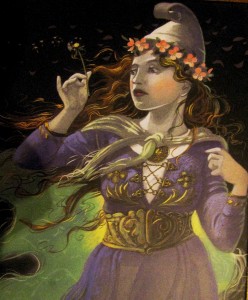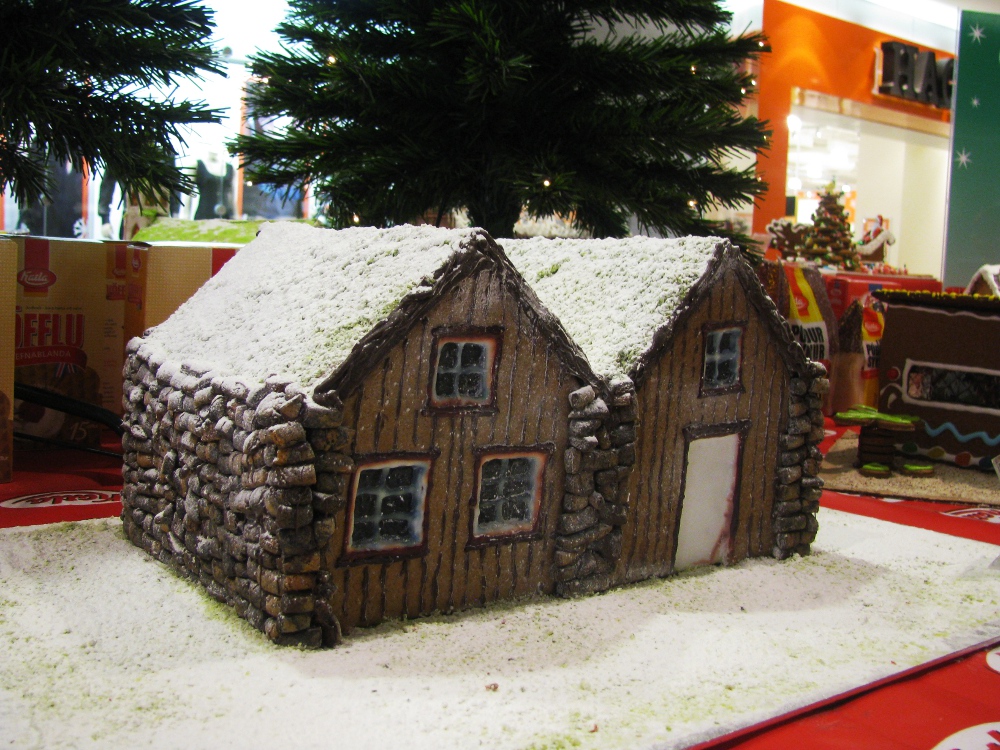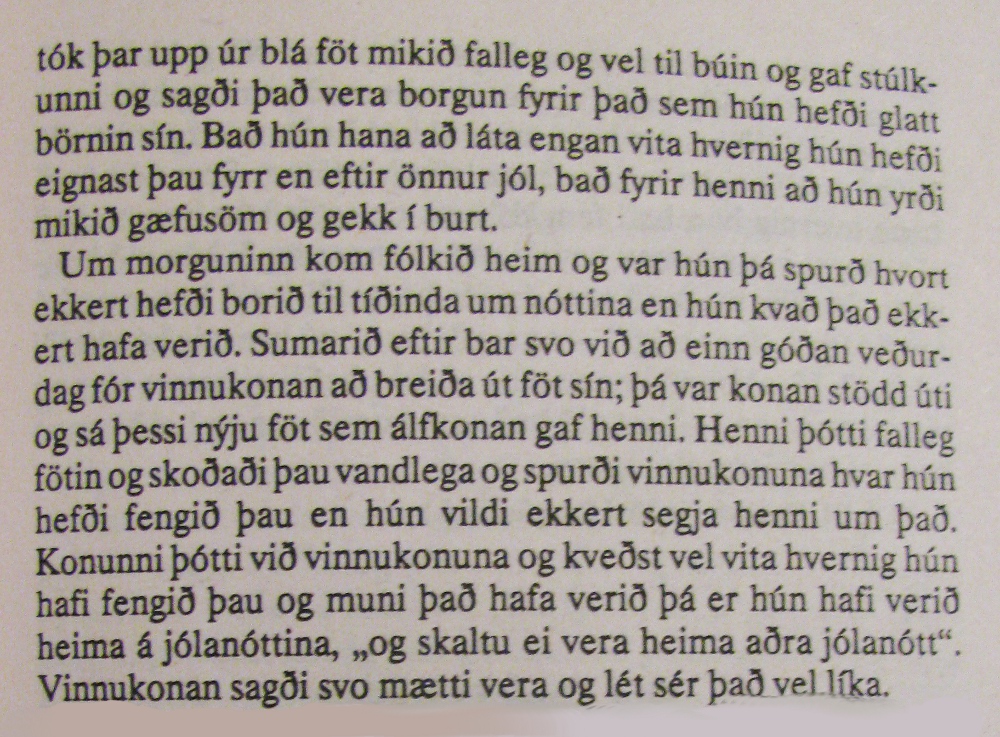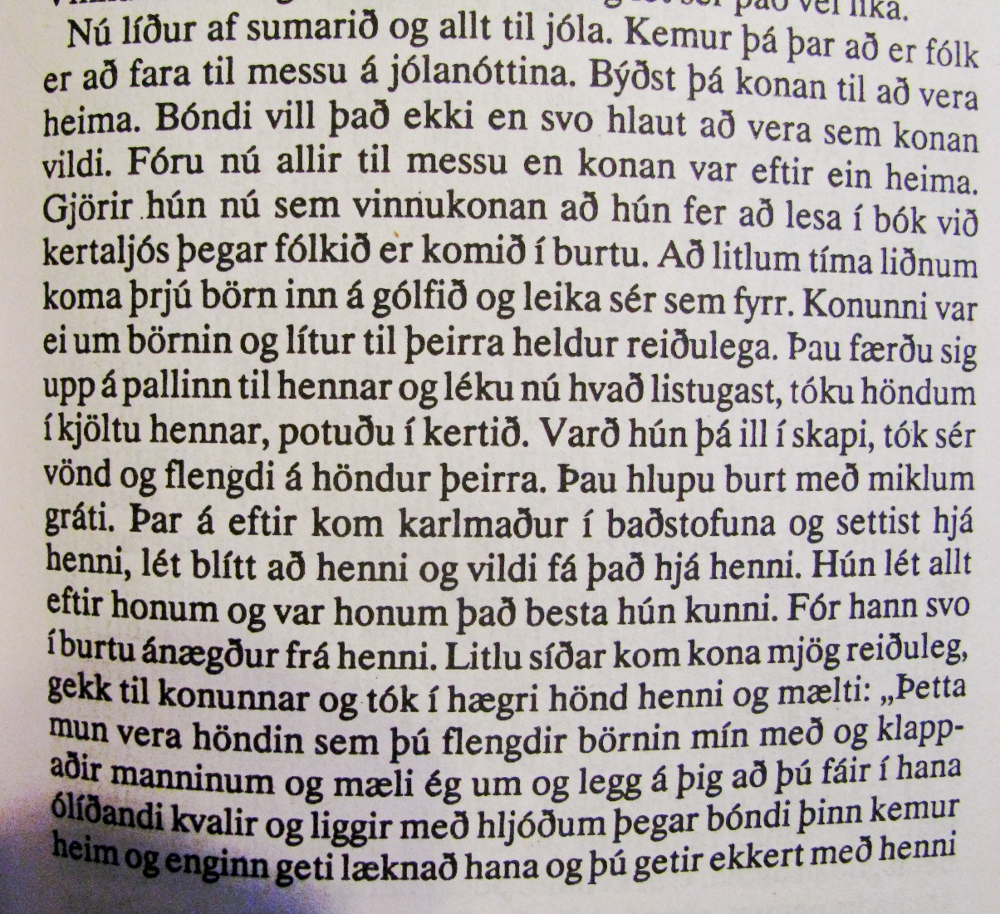A Yule story Posted by hulda on Dec 21, 2013 in Icelandic culture, Icelandic customs, Icelandic history
 Many Icelandic stories of Christmas time are about elves visiting humans, for one reason or another. They’re not always evil after all, many times they may be in need of help instead or just generally curious, even well-meaning if they like their human neighbours. Elves often gave gifts to people they liked in particular and these gifts have been treasured by the families that received them for decades – yes, there are enough elf gifts or wonderfully made items claimed to have elven origin for putting together a whole exhibition, as was done a few years back in Akureyri. Often the way the elves treat you depends on how you treat them first, as the following traditional Christmas story tells.
Many Icelandic stories of Christmas time are about elves visiting humans, for one reason or another. They’re not always evil after all, many times they may be in need of help instead or just generally curious, even well-meaning if they like their human neighbours. Elves often gave gifts to people they liked in particular and these gifts have been treasured by the families that received them for decades – yes, there are enough elf gifts or wonderfully made items claimed to have elven origin for putting together a whole exhibition, as was done a few years back in Akureyri. Often the way the elves treat you depends on how you treat them first, as the following traditional Christmas story tells.
Álfafólkið í Loðmundarfirði (= the elven folk at Loðmundarfjörður)
There was a rich couple who lived in Loðmundarfjörður: they had two male and two female servants. In those days a Christmas mass was held on the Christmas night which most wanted to take part in so that there was often only one person who had to stay behind and look over the house, and that person would sometimes have disappeared* when the people of the house returned.
Now it happened that the people of this house went to the Christmas mass and only one of the female servants stayed behind. When the people were gone she began to read by the light of a candle. When she had read for a short time she saw three children come in to the room and begin to play. She pretended to not see them; they came closer to her and played happily. They drew nearer little by little, put their hands in her lap and poked their fingers in the candlelight as if it amused them. She patted their hands and was kind to them; then she took the candle, broke it into four pieces and gave each child a piece, keeping one for herself. They ran away laughing. A little later came in a man who sat next to her on the bed**, was friendly with her and wished to kiss her and have her as his lover, but she didn’t want him and treated him as harshly as she could so that he soon went away.
Right after that came in a woman clad in blue and with a chest under one arm. She smiled and treated the woman warmly, greeted her and thanked her in place of her children and also that she had not gone with the wishes of her husband. She opened the chest, –
*This is a specific type of haunting in Iceland, often tied with the hidden people: if a person has to be alone in a house during the Christmas night they may disappear or be killed in a brutal way. In most stories no one is left behind alone, until a brave person comes along, volunteers and solves the problem. It’s therefore a note on the rich couple’s characters that they think so highly of their house that they’d rather risk the death of one of their servants than leave the house empty for one night.
**Beds were typically used for sitting in traditional Icelandic houses. A baðstófa has a slightly misleading name – it’s actually a mix of bedroom and living room.
She opened the chest, took out a blue dress, beautiful and masterfully made, giving that to the girl as payment for the happiness she had brought her children. She said that the girl shouldn’t let anyone know how she had gotten the dress until after the next Christmas, said she would become fortunate in her life and went away.
In the morning the others returned and she was asked if anything worth noticing had happened in the night, but she said nothing had happened. The next summer on a beautiful day she spread out the dress;*** the lady of the house happened to be outside and saw the dress that the elf woman had given the other one. She thought the dress beautiful and asked the girl how she had gotten it but she did not want to tell her. The lady replied she knew well how she had managed that and that it must have happened on the Christmas night when she had been left alone to look after the house**** “and you will not stay home for another Christmas night”. The servant replied that it should be so and did not mind.
***This hints that she was airing it out so that it would not get moldy although she must have hidden the dress other times to avoid getting questioned. Mold was and still is a serious problem in Icelandic houses much due to the weather. The only houses that do not get moldy are the new ones that are so well heated that they stay completely dry at all times.
****How could she know? Most likely because of many reasons all rolled into one, large, pointing arrow: the dress was blue, a rare colour otherwise but typically tied to the elven folk. Certain bright shades are to this day used to hint at elven presence. The dress was wonderfully made, another elf quality, and there was also the fact that the girl would not say where it came from – elves typically forbid people from telling if they’ve helped them out or given them presents. A servant girl could barely afford new working clothes, there was no way she could have bought herself a dress like that. To top it all off the lady was well aware of the haunting in her house, and also the fact that this servant girl was the one that had been left to face the haunted night alone.
The summer passed and soon it was Christmas again. Then came the time that people were about the leave for the Christmas mass on the Christmas night. The lady announced she wanted to stay home. Her husband did not wish this but she soon got her way. All the others left now for the mass except for the lady who stayed at home.
Now she did as the servant girl had done and began to read a book in the light of a candle after the others had gone. A little while after the three children come in again and play on the floor as before. This did not please the lady, who looked at them rather sternly. They came closer to her and played a bit mischievously, put their hands in her lap and poked at the candle. This angered her so that she slapped their hands. They ran away crying loudly. Then the man came in and sat next to her, was friendly with her and wished for her company. She allowed everything and was as good to him as she knew how to. Then he went away, satisfied with her.
 A gingerbread artist’s view on the traditional Icelandic house.
A gingerbread artist’s view on the traditional Icelandic house.
A little later the woman came in, furious, went to the lady and took her right hand and said: “this seems to be the hand that slapped my children and petted my husband, and now I will that it’ll be struck with unending pains. You will be lying weeping as your husband comes home, no one can cure you and you yourself can do nothing –
– about it and in the end it will be your death.” Now the hidden woman went away but the lady fell in her bed in pain.
When the people returned home there was little welcome to the husband for the lady could barely say a word for the pain. The husband asked her how she had gotten to the state she was so she told him everything. When the servant girl heard the story she said: “Had you done as I did would things have turned better and you would have gotten a dress like I did,” – and told then to her what had happened to her*****. The lady repented her actions but in the end she did die of the pain in her hand just as had been said.
*****If you think she’s only gloating at the lady’s condition, remember that the elf woman had forbidden her to tell anyone of what had happened until after the next Christmas – she therefore tells her story at the earliest possible chance, the day right after Christmas. It’s a very bad idea to go against the orders of hidden folk!
Know who else are counted among the hidden folk than elves? The trolls of course! Here’s some very Christmas-relevant trolls and how their names sound like in Icelandic. More info about them can be found in this entry I wrote last year. 🙂
Hulda and the Icelandic blog of Transparent Language would like to wish you a Merry Christmas and a Happy New Year – or as we say in Iceland,
Gleðileg jól og farsælt komandi ár!

Build vocabulary, practice pronunciation, and more with Transparent Language Online. Available anytime, anywhere, on any device.
About the Author: hulda
Hi, I'm Hulda, originally Finnish but now living in the suburbs of Reykjavík. I'm here to help you in any way I can if you're considering learning Icelandic. Nice to meet you!








Comments:
Angela Falconbridge:
We may have been visited by hidden folk on 6th January 2017. At noon we heard 2 knocks at our front door which is at the top of several outdoor steps. We can see through the door and could see that there was no one there.
I was in the front roomI at the open window and i heard a small girl giggling.
A few hours later we all heard the doorbell ringing, this time I opened the door, again no one was there and my two girls looked over the pavement and saw no one, again.
Were we visited by hidden folk? And why?
Personally I have seen fairies in UK, which is where we were from originally. They helped me with a negative energy problem.